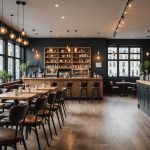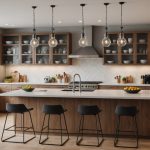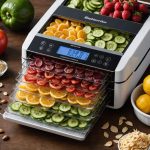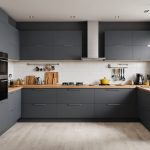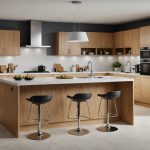Incorporating Bamboo into Kitchen Design
Bamboo kitchen design has gained popularity due to its sustainable aesthetics and versatility. Its advantages extend beyond beauty. Bamboo can be a durable and eco-friendly option for kitchen cabinetry and furniture. Unlike traditional hardwoods, bamboo is a rapid renewable resource, growing much faster, making it a more environmentally responsible choice for your home.
A significant benefit of using bamboo is its ability to blend seamlessly with various design styles and colour palettes. Whether your kitchen is modern, rustic, or minimalist, bamboo can enhance its appeal. The warm, natural tones of bamboo pair well with both vibrant and subdued colour schemes, providing a canvas that complements diverse kitchen aesthetics.
Topic to read : Revamp your culinary oasis: an inspiring guide to modular kitchen designs for seamless upgrades
To incorporate bamboo elements into existing kitchen spaces, consider integrating bamboo countertops, cabinets, or even furniture. You could also start small with bamboo cutting boards or utensil holders. Mix and match these elements with other materials like stainless steel or marble to create a balanced look.
Bamboo’s versatile nature allows for customisation. Should you wish to refresh your kitchen’s look without an extensive renovation, consider bamboo accents like backsplashes or lighting fixtures. Not only will these elevate your kitchen’s aesthetic, but they will also underscore its commitment to sustainability.
Also to see : Unlocking uk building regulations: the ultimate resource for your kitchen makeover journey
Eco-Friendly Bamboo Products for the Kitchen
Harnessing the power of bamboo utensils can truly transform your kitchen into an eco-friendly oasis. Bamboo cutting boards and cooking utensils are not just stylish but significantly more sustainable than plastic or metal alternatives. Unlike other materials, bamboo grows rapidly, making it an environmentally smarter choice.
When selecting these eco-friendly kitchen products, focus on quality to ensure durability and safety. Look for items that are free of preservatives or dyes. Bamboo utensils, known for being lightweight, won’t scratch your cookware, making them a gentle option for daily use. Additionally, they resist moisture and warping, which extends their lifespan compared to traditional materials.
Here’s a tip: Choose thicker bamboo utensils as they tend to be more durable. Their sturdiness makes them ideal for various kitchen tasks, providing a long-lasting solution.
Integrated seamlessly into your kitchen, bamboo’s sustainable aesthetics not only contribute to the environment but also enhance the visual appeal. By choosing bamboo products, you actively reduce your kitchen’s carbon footprint, making an important contribution to protecting our planet. Embracing bamboo for your kitchen essentials champions sustainability without sacrificing style or utility.
DIY Bamboo Projects for a Stylish Kitchen
Embarking on DIY bamboo projects can be both rewarding and transformative for the kitchen. Crafting unique bamboo shelving units can add storage and enhance the room’s visual appeal. Start by measuring the desired space for the shelves and selecting sturdy bamboo planks. Cutting the planks to size, then smoothing the edges ensures a polished look. Finally, secure the shelves to the wall using brackets or floating supports to add a modern, minimalist touch.
Creative repurposing of bamboo offers endless opportunities. Consider using bamboo strips to create a decorative kitchen backsplash. Align the strips vertically or horizontally, adhering them with a suitable adhesive. The natural texture of bamboo adds depth and character to your kitchen’s aesthetic. Additionally, small bamboo planters or herb boxes can adorn countertops, infusing nature into the space.
Budget-conscious individuals can explore cost-effective bamboo enhancements. Utilize leftover bamboo to craft utensil holders or napkin rings. These simple projects personalize kitchen settings while promoting sustainability. Given its versatility, bamboo seamlessly integrates into various kitchen styles—from rustic to contemporary—bringing environmental mindfulness into the heart of the home. With creativity and minimal tools, these projects make sustainable kitchen design accessible to everyone.
Environmental Benefits of Bamboo
Bamboo stands as a paragon of sustainability when comparing natural resources. Its incredibly rapid growth, sometimes reaching maturity in just three to five years, makes it an ideal choice for those conscious of the environmental impact of their material selections. When juxtaposed with conventional materials like hardwoods, which can take decades to mature, bamboo’s renewability shines through, underscoring its minimal destruction of natural forests.
To further illustrate bamboo’s eco-friendly nature, consider its ability to sequester carbon dioxide, thus reducing the carbon footprint. Research suggests that bamboo absorbs carbon more efficiently than many trees, aiding in climate change mitigation. The cultivation process is light on resources, decreasing reliance on pesticides and fertilisers.
By incorporating bamboo into your kitchen, you are not only embracing chic sustainable aesthetics but actively contributing to a greener planet. When you choose bamboo cabinetry or furniture, it’s a step towards lessening ecological harm compared to traditional wood. Each bamboo product utilised minimises deforestation, promotes biodiversity, and supports the natural ecosystem, making your kitchen both stylish and environmentally responsible.
Opt for bamboo to ensure your kitchen’s design is in harmony with nature, enhancing sustainability without sacrificing visual appeal.
Maintaining and Caring for Bamboo Kitchen Products
Properly maintaining bamboo kitchen products ensures their longevity and continued appeal. To keep bamboo surfaces immaculate, regular maintenance is key. Start by cleaning with a damp, non-abrasive cloth. Avoid soaking; bamboo is sensitive to excessive moisture and can warp or weaken.
Protecting bamboo from heat damage is important. Do not place hot pots or pans directly on bamboo surfaces. Use heat-resistant mats or trivets to shield the material. If small burns or scratches appear, minor sanding with fine-grit sandpaper followed by oiling can restore the surface.
Bamboo care includes recognising signs of wear. Over time, bamboo may lose its lustre. Revitalize by applying a natural oil, such as coconut or mineral oil. This practice not only adds shine but creates a moisture barrier, extending the product’s lifespan.
For major blemishes, consider lightly sanding the affected area and reapplying an appropriate finish. These restoration methods maintain bamboo’s vibrant aesthetics while enhancing its durability.
Implement these simple yet effective care tips to prolong the charm and utility of your bamboo kitchen products. With regular upkeep, bamboo can remain a sustainable and stylish choice for years to come.
Case Studies: Transformations with Bamboo
Exploring real-life kitchen transformations can inspire those considering bamboo for home improvements. Several homeowners have experienced remarkable changes by integrating bamboo elements. These bamboo case studies provide insights into the aesthetic and functional benefits bamboo offers.
Many started by replacing traditional wood cabinetry with bamboo counterparts. Not only did this enhance their homes’ sustainable aesthetics, but it also offered a fresh, modern look. One case study featured a couple opting for bamboo cabinetry paired with neutral tones, achieving a serene, eco-friendly kitchen space reflective of their ethos.
- Testimonial: “We were amazed by how the natural tones of bamboo seamlessly blended with our existing decor, adding a unique warmth,” shares one homeowner.
Others have reported success by incorporating DIY bamboo projects like shelving or backsplashes. In particular, a family added bamboo shelves and found them durable yet lightweight, supporting their choice for a minimalist design.
- Lesson Learned: “Be prepared for an initial colour change as the bamboo settles, but this mellows into beautiful hues,” advises a renovator.
These experiences underscore bamboo’s versatility and potential in achieving stylish, eco-conscious kitchen transformations. Each transformation provides valuable lessons and encourages others to explore bamboo’s possibilities.


